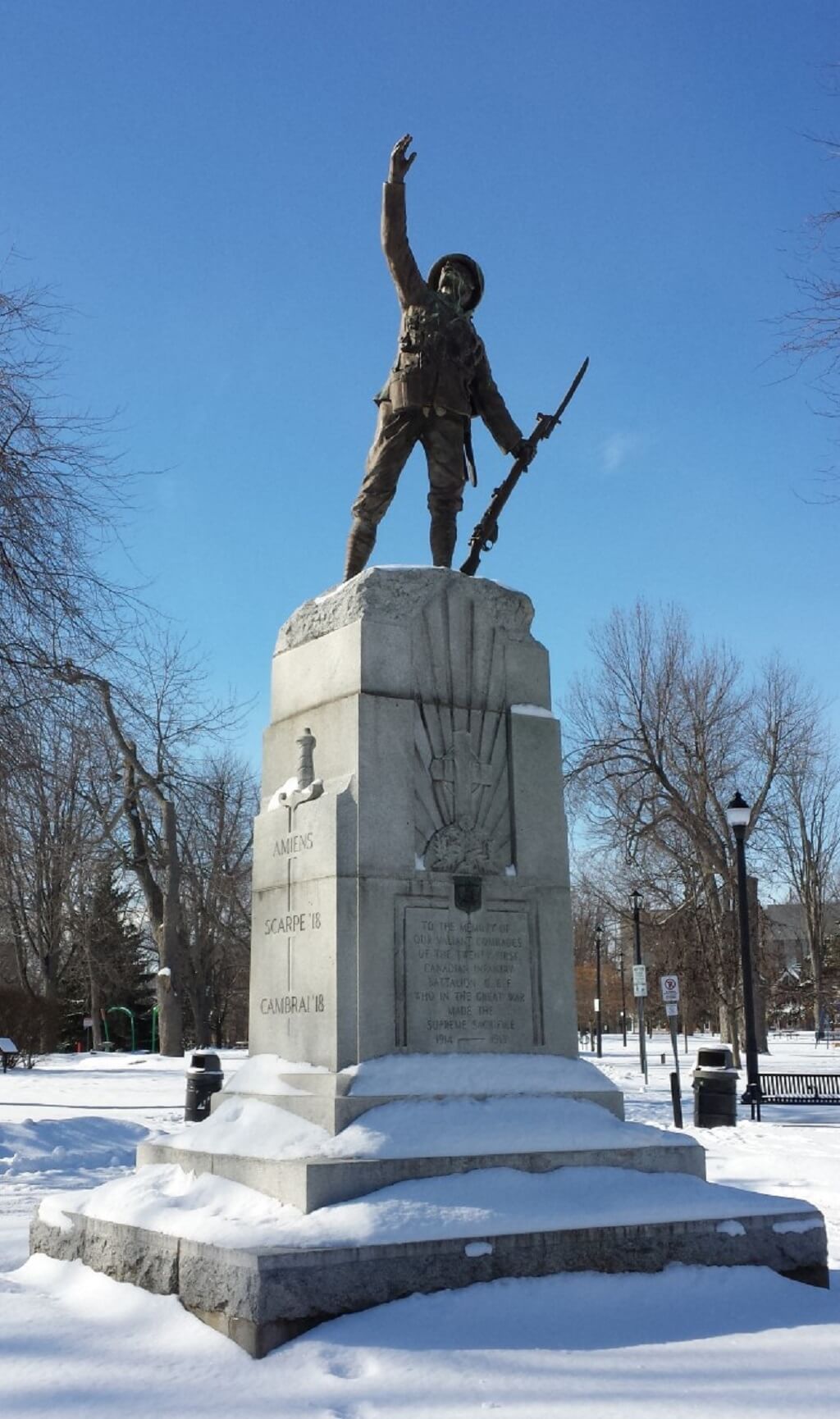Lubomyr Luciuk for New Pathway, Kingston, ON.
My parents took me there when I was a young lad. I recall going into City Park, to the corner of Wellington and West Streets, and walking around the Great War memorial reading the names of the battles where Kingston’s 21st Battalion fought – the Somme, Vimy Ridge, Ypres, Passchendaele, Hill 70. I had no clue as to where those places were or what they echoed.
What I do remember is being puzzled by the statue. A sculpted infantryman stands high on a plinth, gazing upwards. I remember wondering – shouldn’t a fighting man be looking forward, toward the enemy’s trenches? I can’t say I liked this statue, not then. It simply wasn’t martial enough for a boy.
Years later I found myself researching the life of a Great War soldier, Corporal Filip Konowal. He served in the ranks of the 49th Battalion – at the Somme, on Vimy Ridge and then at Hill 70, his valour in that battle earning him a Victoria Cross, the only Ukrainian Canadian ever so distinguished. It seems my interest in Konowal eventually caught the notice of a remarkable group of Kingstonians who had come together determined to recover the memory of the Battle of Hill 70. Under the able leadership of Colonel (retd) Mark Hutchings, and with the patronage of His Excellency David Johnston, the Governor General of Canada, these men and women have already raised several million dollars for a Hill 70 memorial at Loos-en-Gohell, in France. It is being unveiled today, Saturday, 8 April. As you are reading this I am standing there.
I have been to Lens before, on 22 August 2005, unveiling a trilingual plaque and bas relief honouring Corporal Konowal placed on behalf of Branch No. 360 of The Royal Canadian Legion, whose last president was the late John B Gregorovich. Thanks now to the generosity of some proud Canadian Ukrainians – James Temerty, Ihor Ihnatowycz, Nadia Jacyk – and the support of organizations like the Ukrainian Canadian Civil Liberties Foundation and The Shevchenko Foundation – Konowal's valour will be further commemorated for the central pathway at the Hill 70 memorial is being named the Konowal Walk. I am honoured to have done my bit to make that happen. But I am also a proud Kingstonian. And so today, as I stand atop Hill 70, I will be thinking not only about Konowal but about those whose came to this very place some 100 years ago, but never left.
While it is true that we don’t know if any Kingstonians died at Hill 70 what is certain is that at least seven soldiers from our city were killed as that battle raged, between 15-25 August 1917. Lieutenant Frederick Gooch died in action on 15 August, as did Portsmouth’s Private Harold Langsford, and Private Henry Vivian, who enlisted on 11 November 1915 and whose wife Sarah once lived at 236 Wellington Street. Private Thomas McFern, 18, from Amherst Island, was killed “near Lens” on 17th August; his military will, dated 14 March 1917, left his estate to his mother, Rose. Private Marshal Polmateer, from Arden, died in the field on 18th August, Private Charles Bremner, originally from Battersea, on 21st August, and Private Joseph Boyd, a KCVI graduate, on 24th August. From nearby Napanee, Corporal Frank Davern was definitely in the fight. Even though he lied about his age (17) when he enlisted in the 21st he proved a resourceful signaller, winning a Military Medal for bravery at the Somme. In his last letter home, 1 May 1917, he observed his unit had been “very busy lately” at Vimy Ridge, adding that while the enemy “occasionally… reaches out with long range guns that does not trouble us as long as he does not have our name and number on it.” On the 16th August 1917 the enemy did. Davern suffered a serious shrapnel wound to his left leg, dying 3 days later at a casualty clearing station. He now lies buried in the Bruay Communal Cemetery, forever aged 19, one of the 8,677 casualties the Canadian Expeditionary Force took at Hill 70. As for Kingston’s 21st – of the 1,013 volunteers who left our city in May 1915, and moved into the trenches of the Western Front on 18 September 1915, only 103 were still with the battalion when it marched into Germany in 1918.
When I come home in a few days I will go to City Park and stand by the war memorial again. I finally realize what its creator intended. On the monument’s front, facing east, are carved the poppies of Flanders Fields adorned with a Cross, sacred symbols of the sacrificed surrounded by the upward-flowing rays of a stylized sunrise. I shall pause, face east, and offer up a prayer for those who never returned from France. I now understand that, for more years than I have been alive, this centurion has stood not simply to herald triumphs won on earthly battlegrounds but as a reminder of the hope of the Resurrection, the very message of Easter. Often it takes the passage of much time before you see clearly.
Share on Social Media




































